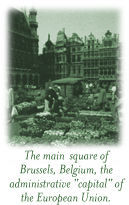Money
Matters: An IMF Exhibit -- The Importance of Global Cooperation
|
Globalization
and Integration (1989-1999)
|
Part
6 of 8
|
|
|
|
| |
European
Economic Unity
|
| <--Previous
|
Next--> |
| |
| For
the first time since the Roman Empire, Europe now shares a single
currency – the euro. Introduced January 1, 1999, the euro represents
the culmination of European economic integrations, which began in
the 1950s.
|

credits
|
Cooperation
in Europe
|
|
The
European Union manages political and economic cooperation among
its 15 member countries. Born in the hope that shared sovereignty
would make another war in Europe unthinkable, the European Union
is dedicated to creating an ever closer political and economic union
among the peoples of Europe.
|
Economic
and Monetary Union
|
|
The
introduction of a common euro currency marks the final phase of
Europe’s Economic and Monetary Union (EMU). As of January 1999,
the euro is the currency for eleven countries (four European Union
countries have opted out at this time):
- Euroland
(the euro zone) accounts for almost 20% of world trade and world
GDP.
- Euroland
is the world’s second largest economy.
|
|
|
| |
|
| <--Previous
|
Next--> |